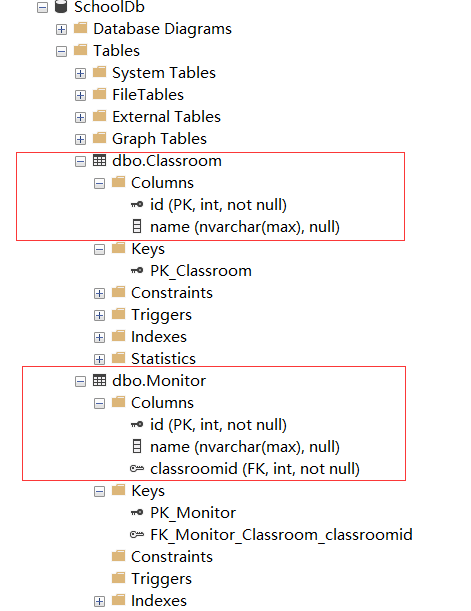From Existing Database
24 Apr 2020 | CSharp-EFHere, I will illustrate how to generate Context and Entities from an existing database. As the Entity Framework Core doesn’t provide a visual designer, so we need to use the Scaffold-DbContext command.
I have a database which already populated.

Scaffold-DbContext Command
Use Scaffold-DbContext to create models is easy. get its syntax and details by running the get-help entityframeworkcore or get-help Scaffold-DbContext command on Package Manager Console:
Scaffold-DbContext [-Connection] <String> [-Provider] <String> [-OutputDir <String>] [-ContextDir <String>] [-Context <String>] [-Schemas <String[]>] [-Tables <String[]>] [-DataAnnotations] [-UseDatabaseNames] [-Force] [-Project <String>] [-StartupProject <String>] [<CommonParameters>]
In this situation, run the following code on NuGet package manager:
PM> Scaffold-DbContext "Server=.;Database=SchoolDB;Trusted_Connection=True;" Microsoft.EntityFrameworkCore.SqlServer -OutputDir Models
it will create a models folder, and put the entity and context class into it.

The generated code:
public partial class SchoolDBContext : DbContext
{
public SchoolDBContext(){}
public SchoolDBContext(DbContextOptions<SchoolDBContext> options): base(options){}
public virtual DbSet<Classroom> Classroom { get; set; }
public virtual DbSet<Monitor> Monitor { get; set; }
protected override void OnConfiguring(DbContextOptionsBuilder optionsBuilder)
{
if (!optionsBuilder.IsConfigured)
{
#warning To protect potentially sensitive information in your connection string, you should move it out of source code. See http://go.microsoft.com/fwlink/?LinkId=723263 for guidance on storing connection strings.
optionsBuilder.UseSqlServer("Server=.;Database=SchoolDB;Trusted_Connection=True;");
}
}
protected override void OnModelCreating(ModelBuilder modelBuilder)
{
modelBuilder.Entity<Classroom>(entity =>
{
entity.Property(e => e.Id).HasColumnName("id");
entity.Property(e => e.Name).HasColumnName("name");
});
modelBuilder.Entity<Monitor>(entity =>
{
entity.HasIndex(e => e.Classroomid);
entity.Property(e => e.Id).HasColumnName("id");
entity.Property(e => e.Classroomid).HasColumnName("classroomid");
entity.Property(e => e.Name).HasColumnName("name");
entity.HasOne(d => d.Classroom)
.WithMany(p => p.Monitor)
.HasForeignKey(d => d.Classroomid);
});
OnModelCreatingPartial(modelBuilder);
}
partial void OnModelCreatingPartial(ModelBuilder modelBuilder);
}
public partial class Monitor
{
public int Id { get; set; }
public string Name { get; set; }
public int Classroomid { get; set; }
public virtual Classroom Classroom { get; set; }
}
public partial class Classroom
{
public Classroom(){Monitor = new HashSet<Monitor>();}
public int Id { get; set; }
public string Name { get; set; }
public virtual ICollection<Monitor> Monitor { get; set; }
}
As you can see, what’s applied is that the Fluent-API. However, if you want to use the DataAnnotations, then you should add the -DataAnnotations at the end of the command.
PM> Scaffold-DbContext "Server=.;Database=SchoolDB;Trusted_Connection=True;" Microsoft.EntityFrameworkCore.SqlServer -OutputDir Models -DataAnnotations
the generated code:
public partial class SchoolDBContext : DbContext
{
public SchoolDBContext(){}
public SchoolDBContext(DbContextOptions<SchoolDBContext> options): base(options){}
public virtual DbSet<Classroom> Classroom { get; set; }
public virtual DbSet<Monitor> Monitor { get; set; }
protected override void OnConfiguring(DbContextOptionsBuilder optionsBuilder)
{
if (!optionsBuilder.IsConfigured)
{
#warning To protect potentially sensitive information in your connection string, you should move it out of source code. See http://go.microsoft.com/fwlink/?LinkId=723263 for guidance on storing connection strings.
optionsBuilder.UseSqlServer("Server=.;Database=SchoolDB;Trusted_Connection=True;");
}
}
protected override void OnModelCreating(ModelBuilder modelBuilder)
{
modelBuilder.Entity<Monitor>(entity =>
{
entity.HasIndex(e => e.Classroomid);
});
OnModelCreatingPartial(modelBuilder);
}
partial void OnModelCreatingPartial(ModelBuilder modelBuilder);
}
public partial class Monitor
{
[Key]
[Column("id")]
public int Id { get; set; }
[Column("name")]
public string Name { get; set; }
[Column("classroomid")]
public int Classroomid { get; set; }
[ForeignKey(nameof(Classroomid))]
[InverseProperty("Monitor")]
public virtual Classroom Classroom { get; set; }
}
public partial class Classroom
{
public Classroom(){Monitor = new HashSet<Monitor>();}
[Key]
[Column("id")]
public int Id { get; set; }
[Column("name")]
public string Name { get; set; }
[InverseProperty("Classroom")]
public virtual ICollection<Monitor> Monitor { get; set; }
}
Here it is the DataAnnotation now!

Comments